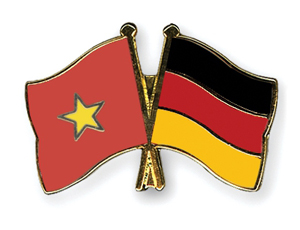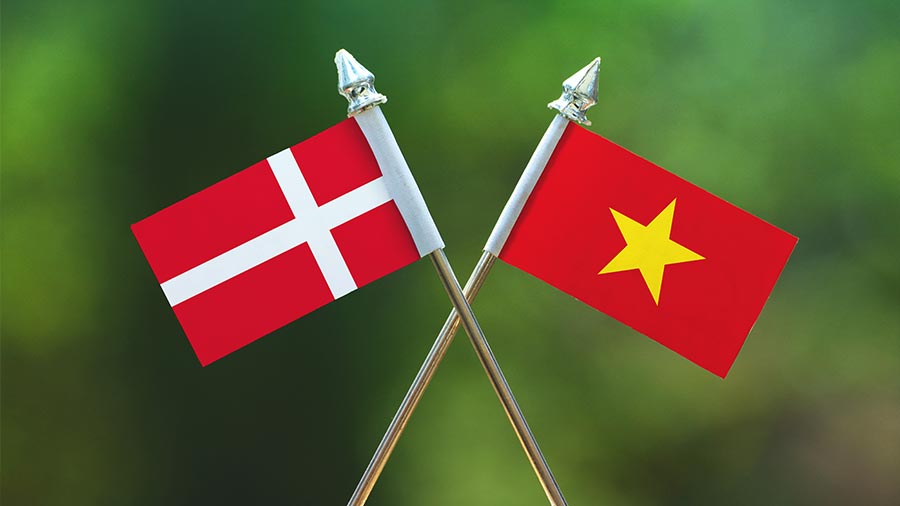Vietnam-German Connections
By Alex Tangkilisan
 Aug. 30 – Vietnam, one of the key member-states of the Association of Southeast Asian Nations (ASEAN), covers a total area 331,210 sq. km – making it almost the same size as Germany. In addition to the size connection, there is also a people connection with over 125,000 Vietnamese or Germans of Vietnamese descent living in Germany and over 100,000 German-speakers currently residing in Vietnam.
Aug. 30 – Vietnam, one of the key member-states of the Association of Southeast Asian Nations (ASEAN), covers a total area 331,210 sq. km – making it almost the same size as Germany. In addition to the size connection, there is also a people connection with over 125,000 Vietnamese or Germans of Vietnamese descent living in Germany and over 100,000 German-speakers currently residing in Vietnam.
Connections through trade
In 2012, Germany solidified its position as Vietnam’s principal EU trading partner with bilateral trade reaching an all-time high of US$9.4 billion between the countries. Of that number, Germany imported US$6.81 billion worth of goods from Vietnam (up 27.7 percent year on year), while exporting US$2.59 billion worth of goods to Vietnam (up 9.9 percent year on year).
 RELATED: Dezan Shira & Associates’ Global Services
RELATED: Dezan Shira & Associates’ Global Services
Further, the Vietnam General Department of Customs recently announced that bilateral trade between the two countries has already reached US$6.047 billion through the first half of 2013, broken down into US$3.695 of German imports of Vietnamese goods (up 29.51 percent year on year) and US$2.352 billion worth of German exports to Vietnam (up 22.35 percent year on year).
For comparison, two-way trade between Vietnam and Germany topped out at around US$3.3 billion just five years ago.
These numbers are seemingly set to skyrocket even higher in the near future, as Vietnam and the EU plan to sign a free trade agreement (FTA) on goods, services, investment, government procurement and protection of intellectual property rights by 2014. Once the FTA is in effect, import-export tariffs on agricultural products, food, footwear, garments and other products will be cut to zero.
To further break it down, Germany’s principal imports from Vietnam consisted of footwear, textiles, agricultural products (e.g., coffee and pepper), seafood, electronic goods and furniture. On the other hand, Germany’s principal exports to Vietnam consisted of machinery, motor vehicles, equipment and chemical products.
Peter Kompalla from the Delegation of German Industry and Commerce in Vietnam commented on the growing trade relationship between Vietnam and Germany, noting: “The interest of German companies in the Vietnamese market is very strong. The number of German companies planning to expand their business activities has almost tripled. Moreover, we notice an increasing interest of Vietnamese companies in the European market with Germany as an entry point. The number of exhibitors that have been acquired by our trade fair representatives has increased by one-third since last year.”
Not only are trade ties improving between the two countries, but so are investment values as of late. Foreign investment into Vietnam was virtually nonexistent a decade ago, but over the last five years the country has seen annual foreign direct investment (FDI) inflows of between US$10 billion-US$11 billion.
Just last year, Germany contributed nearly US$1 billion to Vietnam’s total FDI.
Why invest in Vietnam?
There are many reasons to invest in Vietnam, including the relatively low labor cost of conducting business there. However, on top of the low labor costs, Vietnam also offers foreign companies many incentives to invest such as fairly large tax breaks with competitive corporate income tax (CIT) rates.
Specifically, starting January 1, 2014, CIT rates will be cut to 22 percent (from the current 25 percent) before being further cut to 20 percent starting January 1, 2016. Not only that, but small to medium enterprises (SMEs) with fewer than 200 employees and total revenues of less than 20 billion dong (US$950,887) will be subject to a CIT rate of just 20 percent starting July 1, 2013, which will get further cut to 17 percent by January 1, 2016.
There are also a variety of sectors from which you can choose to invest. The German Chamber has ranked them in terms of market potential as follows:
- Medical technology/very high;
- Mechanical engineering/high
- Chemistry/high;
- Electronics/high
- Environment engineering/high
- Energy/ high
- Textile/moderate; and
- Construction/low.
“In a dynamic market like Vietnam, potential arises in various industries. Important, however, is to be well prepared, to spend time on a comprehensive market analysis and to have professional support. In sales, for example, we often see products that are too sophisticated with USPs that do not suit the needs of the market yet,” Mr Kompalla added with regard to looking for the perfect industry to enter into.
Vietnam also has a 42 million strong workforce (defined as adults aged 23-65) that is expected to jump to 65 million over the next 20 years, adding to the appeal of coming into the country.
The appeal
Vietnam has become somewhat of a magnet for German companies with a Chinese presence over recent years thanks to the country’s lower costs in comparison to China and its relatively skilled and abundant workforce. Specifically, labor costs for unskilled workers in Vietnam are typically between US$100-US$150 a month (compared to around US$300 per month throughout China).
Holger Benthien, vice chairman of the German Business Association, spoke of the trends recently, noting that “German companies looking at Asia have established their presence in China already, and the next country that comes to their mind is Vietnam because of its stability and dedicated workforce.”
On top of all of this, Germany’s own Vice-Chancellor and Federal Minister of Economics and Technology Philipp Roesler was actually born in Vietnam – further cementing the ties between the two countries which have been bolstered by the high number of German delegations sent to Vietnam over the past five years to boost strategic and economic partnerships.
Mr Kompalla further commented on the efforts between Germany and Vietnam, saying: “The co-operation between Germany and Vietnam can be observed in numerous projects. In recent years, the German government supported Vietnam in developing infrastructure and buildings, healthcare, education as well as the environmental sector. Among the so called ‘Strategic Partnership’ between both countries is the construction of a ‘German House’ in Ho Chi Minh City, the construction of a subway system and a Vietnamese-German-university.”
Are there any problems?
However, as all things that seem too good to be true, Vietnam is not without its own set of unique problems.
For one, inflation rates have grown over the past months to over 7 percent after hitting an eight-month low of 6.36 percent last May. Further, Vietnam’s GDP grew by only 5.03 percent last year – the lowest growth rate the country has experienced since 2000, and lower than the government’s official projections. This also represented the country’s second lowest growth rate since 1999, when it only grew by 4.77 percent.
For comparison, the country grew by 6.5 percent on average between 2007-2011, down one percent from the previous five-year period.
However, despite inflation and sluggish GDP growth rates, the Vietnamese government is currently taking steps to rectify the situation by way of governmental policies and banking reforms.
“Despite the challenges, German investors do take the opportunity to expand their businesses into Vietnam. The market entry costs have never been as low as at the moment, and foreign investors can benefit from the nose-diving real estate market – leasing prices have been pulled down in Vietnam’s more than 200 very well developed and managed industrial zones that are distributed over all parts of the country,” remarked Mr Kompalla on Vietnam’s current economic slowdown.
Despite the problems, which every destination has, Vietnam continues to be a promising country for German investors and companies looking to expand their footprint in the fast growing ASEAN region.
Dezan Shira & Associates is a specialist foreign direct investment practice, providing corporate establishment, business advisory, tax advisory and compliance, accounting, payroll, due diligence and financial review services to multinationals investing in emerging Asia. Since its establishment in 1992, the firm has grown into one of Asia’s most versatile full-service consultancies with operational offices across China, Hong Kong, India, Singapore and Vietnam as well as liaison offices in Italy and the United States.
For further details or to contact the firm, please email vietnam@dezshira.com, visit www.dezshira.com, or download the company brochure.
You can stay up to date with the latest business and investment trends across Vietnam by subscribing to The Vietnam Advantage, our complimentary update service featuring news, commentary, guides, and multimedia resources.
Related Reading
 An Introduction to Tax Treaties Throughout Asia
An Introduction to Tax Treaties Throughout Asia
In this issue of Asia Briefing Magazine, we take a look at the various types of trade and tax treaties that exist between Asian nations. These include bilateral investment treaties (BITs) and also the meatier double tax treaties (DTAs) and free trade agreements (FTAs) that directly affect businesses operating in Asia.
 Vietnam’s International Taxation Agreements
Vietnam’s International Taxation Agreements
In this issue, we will first look at the broader context of global trade and the growing salience of Free Trade Agreements (FTA) between Vietnam and its trade partners. We will examine the effects of current FTAs on Vietnam’s exports, the advantages and disadvantages thus far, as well as the response of Vietnamese enterprises to the policies of the FTAs in effect.
Vietnam’s Bilateral Investment Treaties
Introduction to Double Taxation Avoidance in Vietnam
How to Avoid Double Taxation in Vietnam
- Previous Article Positive Outlook for European Companies Operating in Vietnam
- Next Article Vietnamese Infrastructure: Ho Chi Minh City
































